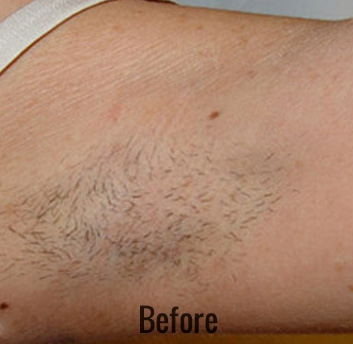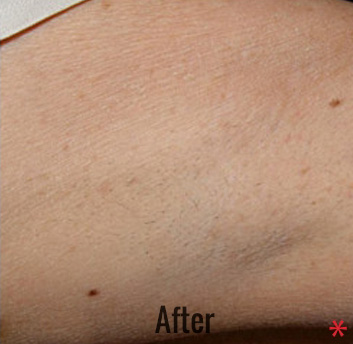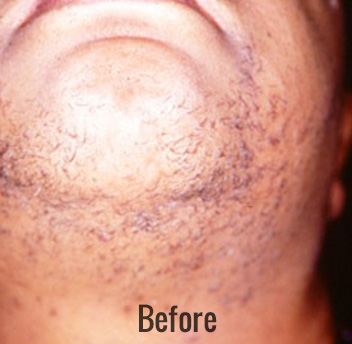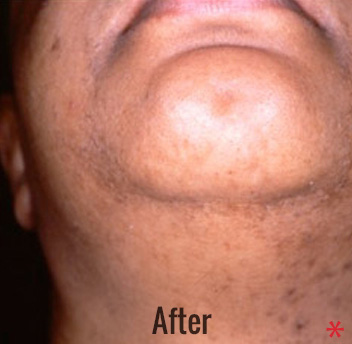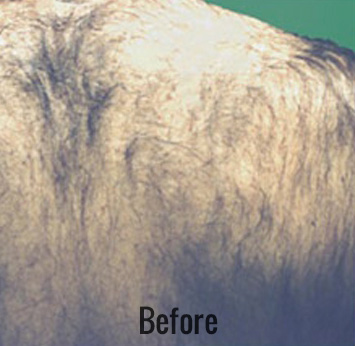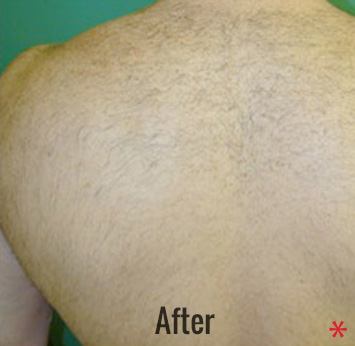Laser Hair Removal
Consultations offered at our seven convenient locations in Brea, Costa Mesa, Glendora, Lancaster, Rancho Cucamonga, Whittier and West Hollywood

Laser Hair Removal is a way to permanently reduce unwanted hair. Managing body and facial hair can be an ongoing struggle—but only if you’re doing it wrong! Other hair removal treatments just trim or pluck hairs, leaving the follicle intact and allowing hair to eventually grow back. Laser hair removal gets to the root of the problem.
Precise laser energy targets the hair follicles, disrupting their cellular structure and keeping them from producing more hairs. Laser hair removal can be performed nearly anywhere on the body, and after each round of laser hair removal treatment, fewer hairs grow back. When you’ve completed several laser hair removal sessions, you’ll enjoy smoother, stubble-free skin that’s ready for our Southern California lifestyle.
If you’re ready to give up the razors, waxes, creams, and tweezers, Skin Perfect Medical Aesthetics is ready for you.
We have locations in Brea, Lancaster, Rancho Cucamonga, Costa Mesa, Glendora, and Whittier, so no matter where you are in the Southland, there’s an office near you! Contact us today to forget your hairy problems!
Contents
- 1 Before and After Photos
- 2 How Do Lasers Remove Hair?
- 3 Why Does It Take More Than One Session of Laser Hair Removal?
- 4 Long Term Benefits
- 5 Candidates for Laser Hair Removal in Southern California
- 6 Personal Consultation
- 7 Perfect Preparation for Skin Perfect
- 8 Procedure
- 9 Recovery
- 10 Good Riddance to Unwanted Hair
- 11 How Much Does Laser Hair Removal Cost in Southern California?
- 12 FAQ
- 13 References
Before and After Photos
How Do Lasers Remove Hair?
Lasers have many useful medical and cosmetic applications. They can help with life-saving surgery, treat painful varicose veins, or remove regrettable tattoos. Laser therapy uses an intense beam of light energy that is controlled and aimed to target certain tissues while leaving others unharmed. Regardless of the laser therapy application, when used on the skin, lasers work on the principle of selective photothermolysis. The intense light from the laser creates a high temperature that is absorbed by darker-colored tissue components: chromophores. For hair removal, it’s the melanin in the hair follicle that attracts the laser energy. The hair follicle is then destroyed by the heat and is no longer able to produce hair. The surrounding tissue is left undamaged. (1) Lasers for hair removal also have a cooling device that ensures that the patient’s skin is protected during the hair removal session. For those with dark, coarse hair, laser therapy is particularly effective. Laser hair removal works best when the targeted hair has a high concentration of chromophores. (1)
Why Does It Take More Than One Session of Laser Hair Removal?
Don’t blame the laser—blame that pesky hair. Each and every hair on your entire body is in a different stage of growth at any given time.
The process of hair growth occurs in distinct ordered stages:
- Anagen: the active growth phase
- Telogen: the resting stage
- Catagen: the regression of the hair follicle phase,
- Exogen: shedding of hair
- Kenogen: the phase between the empty hair follicle and the growth of a new hair.
That’s why you might lose an eyelash here and there, but don’t suddenly lose your eyebrows!
Laser hair removal only works on hair that is in the anagen phase, since that’s when the hair has melanin to target. Because the rest of your hair may be in any other phase at any given time, you’ll need to come back over the course of several months to make sure that the laser catches other follicles when their hairs enter the anagen phase. (2)
Long Term Benefits
Imagine not having to shave – ever again. Popular treatment areas include underarms, bikini areas, backs, and upper lips.
Laser Hair removal offers:
- Less ingrown hairs
- Smoother skin
- No downtime
- Treat large or multiple areas quickly
- Saves time
- No more nicks, skin irritation, or razor burns.
Candidates for Laser Hair Removal in Southern California
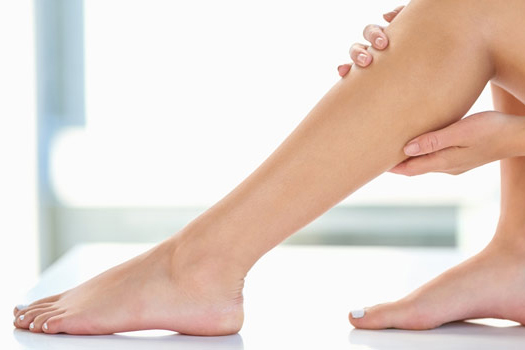
Laser hair removal patients wish to lessen and remove unwanted hair. Ideal candidates for laser hair removal have dark hair against healthy light skin. Because the laser concentrates its energy on dark pigmentation, a significant contrast between the color of the hair and skin is ideal. As a result, those with less melanin in their skin and lighter hair may not be ideal candidates for laser hair removal.
Schedule a consultation at Skin Perfect with our certified laser technicians at our locations in Rancho Cucamonga, Lancaster, Whittier, Brea, Costa Mesa, or Glendora to determine whether you are a good candidate for laser hair removal.
Personal Consultation
During your personal consultation, one of our certified laser technicians will answer any questions you may have. We will discuss your concerns and review your skincare history.
It is crucial to apply sunscreen regularly prior to and following the procedure in order to minimize your risk of hyperpigmentation or irritation in the treatment area.
The number of treatments will vary from patient to patient and may be anywhere from 5 to 7 sessions. Like all laser procedures, multiple treatments are required to achieve the best results. Your skin tone, hair color, hair thickness, and coarseness will determine how many laser treatments will be necessary for long-lasting and effective hair removal. These specifics will be discussed in your consultation prior to treatment.
Perfect Preparation for Skin Perfect
It’s important to make sure that the area for hair removal is ready for laser hair removal.
- Shave the treatment area within 24 hours of the treatment. Long hair will burn while being treated with the laser.
- Don’t wax or pluck the area being treated between or prior to sessions. Remember—it’s the dark color of the hair that allows the laser energy to affect the hair follicle!
- Make sure that the treatment area needs to be free of makeup, lotion, deodorant, and sunscreen.
- Refrain from treating an area that was exposed to the sun within 4 weeks prior to treatment because it cannot be treated.
- Do not use fake tanning products 3-4 weeks prior to treatment.
Procedure
Depending on the size and number of areas you will have treated, your laser hair removal appointment may take as little as a few minutes or over an hour. Your laser technician will prep the treatment area and provide you with protective glasses to wear during the procedure.
As the laser technician gently slides the handheld laser device across your skin, laser energy targets the hair follicles. You may feel a slight stinging sensation during each pulse of the laser. Discomfort is usually minimal, but depending on the sensitivity of the area being treated, you may opt for a topical numbing cream to be applied before your session begins.
Recovery

After your laser hair removal session ends, your skin may feel sensitive and have mild swelling or redness. This is temporary and should subside within a few hours. Avoid hot showers and using skincare products like perfume on the treatment area for a few days. Direct sun exposure and artificial tanning should be avoided for 6 weeks after treatment. To further protect your skin, be sure to apply sunscreen daily to help prevent hyperpigmentation and burning while you are outside.
Good Riddance to Unwanted Hair
In the week following your laser session, you’ll notice that the hair in your treatment area seems more prominent—but it’s not growing, it’s about to fall out! Depending on the area(s) that you’re treating and how well your hair reacts to the laser, you should begin to notice less hair after your first few treatments. Patience is key. Remember, after a full round of successful laser treatments, you won’t have to think about hair removal again!
How Much Does Laser Hair Removal Cost in Southern California?
The cost of your laser hair removal will depend on the areas you choose to treat, and the number of treatments required to achieve satisfactory results. During your personal consultation, our experienced laser technicians will be able to estimate the number of treatments and the cost of your laser hair removal procedures. Skin Perfect offers financing options to help you get started on finally getting rid of unwanted hair. To see what other services we provide, follow our blog.
FAQ
How does a laser remove hair?
The laser hair removal device applies a concentrated beam of light that penetrates the skin, targeting the pigmented root of the hair. The laser energy heats this structure and destroys the hair follicle, causing the hair to fall out, and preventing new hair from growing.
Is laser hair removal painful?
Some patients report a stinging sensation as the laser pulses. For sensitive areas, a topical numbing cream can be applied.
Why does it take more than one session for laser hair removal?
Because the laser targets the melanin, or the chromophore of the hair, only hair with melanin can absorb the energy and destroy the hair follicle with the conducted heat. Hair only has melanin during the anagen phase of growth—when the hair is actively growing. Not all hairs are in the same growth phase at the same time, so you’ll need to return for additional treatments to ensure that all of the hairs are treated while in the anagen phase.
Does laser hair removal work on redheads?
Because the laser energy targets the dark pigmentation of the hair, those with very light-colored hair may not be good candidates for laser hair removal. The ideal candidate for laser hair removal has dark hair and lighter skin.
Are there any side effects for laser hair removal?
You may experience swelling, sensitivity, and redness after a laser hair removal session. This can be treated with icepacks and over-the-counter pain medication to ease discomfort. Avoid using perfumes or lotions on the treatment area in the days following your treatment. Do not expose the area to excessive sunlight in the months before and the days after your treatment. If you’re planning to have laser hair removal on an area that is typically exposed, like your face, be sure to use sunscreen consistently in the weeks leading up to your treatment session.
References
- Liew, S.H. Laser Hair Removal. Am J Clin Dermatol 3, 107–115 (2002). https://doi.org/10.2165/00128071-200203020-00004
- Bhat YJ, Bashir S, Nabi N, Hassan I. Laser Treatment in Hirsutism: An Update. Dermatology Practical & Conceptual. 2020;10(2). doi:10.5826/dpc.1002a48

